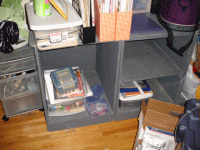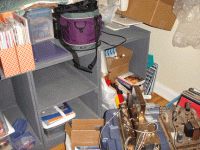I need to make a portable table to put my turntables and mixer on when I DJ at house parties. I made one from kitchen worktop reinforced underneath with 1 inch square steel tube. It works very well but is too long and heavy to transport easily.
I am thinking about making a table that can be folded in two - a bit like a pasting table. I was wondering if a 'skinned frame' design might be good, to save weight. I could build it all from MDF - a 9mm or 12mm frame skinned with 6mm panels. Do people think this would be good, or should I take the solid and heavy approach?
I am thinking about making a table that can be folded in two - a bit like a pasting table. I was wondering if a 'skinned frame' design might be good, to save weight. I could build it all from MDF - a 9mm or 12mm frame skinned with 6mm panels. Do people think this would be good, or should I take the solid and heavy approach?
As I understand it the negative situation that decks suffer from at clubs etc. is one of bass feedback.
You don't really give a lot of detail concerning your current solution other than it is made from kitchen worktop. Presumably this is melamine skinned chip board. Does the reinforcing frame also form the legs? How rigid is the structure as a whole?
I don't think you will have a problem with your proposed light weight solution. The relative mass difference between the two solutions is not that great except in a human 'blooming heck that's heavy' sense.
A couple of things I would say though:
1/ Fill any internal cavity with light weight insulation - you don't want the whole thing to become a sounding board.
2/ Where the two halves are hinged I suggest you allow for some removable bracing between the two parts. Ideally you want the entire structure to be as rigid as possible.
You don't really give a lot of detail concerning your current solution other than it is made from kitchen worktop. Presumably this is melamine skinned chip board. Does the reinforcing frame also form the legs? How rigid is the structure as a whole?
I don't think you will have a problem with your proposed light weight solution. The relative mass difference between the two solutions is not that great except in a human 'blooming heck that's heavy' sense.
A couple of things I would say though:
1/ Fill any internal cavity with light weight insulation - you don't want the whole thing to become a sounding board.
2/ Where the two halves are hinged I suggest you allow for some removable bracing between the two parts. Ideally you want the entire structure to be as rigid as possible.
Yes it's just normal worktop and the bars are just two running the length of the worktop screwed on. The legs are tubular screw on legs that bolt onto the worktop.
The skinned design becoming a sounding board is a worry, that was why I proposed internal bracing. Can you elaborate why stuffing is needed if it's braced?
For the hinge I was thinking of a piano hinge. I wondered if the weight of the decks holding the hinge shut would be rigid enough?
The skinned design becoming a sounding board is a worry, that was why I proposed internal bracing. Can you elaborate why stuffing is needed if it's braced?
For the hinge I was thinking of a piano hinge. I wondered if the weight of the decks holding the hinge shut would be rigid enough?
Hum, I now understand the structure you are intending to build. Even if braced internally there is a danger that any hollow void may act as a sounding board, much like the internal cavity in an acoustic guitar. This can easily be avoided by filling any voids with the kind of insulation used in loft insulation or similar.
However, I can foresee a potential issue which you should seek to avoid and it is a strangely pragmatic one. The problem relates to your stated intention of lowering the overall weight of your stand. If it is constructed with twin skins of 6mm MDF and reinforced internally, you may well find (in fact I'm pretty certain you will) that it isn't much less heavy than your existing design. A 12mm sheet of MDF (2X 6mm) plus bracing, plus hinges etc soon adds up.
I have built surprisingly similar constructions to the type you propose and I would not use the piano hinge you suggest in the way you intend. I am certain that the two halves when open will have way too much 'bounce' and be much less rigid than your current solution. I would use bolted on side cheeks to stiffen the structure.
As an alternative have you thought about adapting your existing design. How about getting rid of the metal bracing (not sure why you need this any way), cut a bunch of large holes in it to reduce the weight, cut it in half and re-join with piano hinge and add the light weight bracing to brace the structure when un-folded.
However, I can foresee a potential issue which you should seek to avoid and it is a strangely pragmatic one. The problem relates to your stated intention of lowering the overall weight of your stand. If it is constructed with twin skins of 6mm MDF and reinforced internally, you may well find (in fact I'm pretty certain you will) that it isn't much less heavy than your existing design. A 12mm sheet of MDF (2X 6mm) plus bracing, plus hinges etc soon adds up.
I have built surprisingly similar constructions to the type you propose and I would not use the piano hinge you suggest in the way you intend. I am certain that the two halves when open will have way too much 'bounce' and be much less rigid than your current solution. I would use bolted on side cheeks to stiffen the structure.
As an alternative have you thought about adapting your existing design. How about getting rid of the metal bracing (not sure why you need this any way), cut a bunch of large holes in it to reduce the weight, cut it in half and re-join with piano hinge and add the light weight bracing to brace the structure when un-folded.
In the past I've moved quite frequently, so I built a place for my dj decks made of mdf. The top is a solid piece of 3/4" mdf, and the base is made of 1/2" mdf.
I've never had any problems with resonance, or with finding a place to stash records, amplifiers and what not.
Since I no longer dj, my wife now uses it as craft storage... bear that in mind with the pics:
I've never had any problems with resonance, or with finding a place to stash records, amplifiers and what not.
Since I no longer dj, my wife now uses it as craft storage... bear that in mind with the pics:
Attachments
I did think the piano hinge might be too bouncy.
Good point on the weight saving maybe not being upto expectations.
I braced the worktop because after 6 months of it being in the room it had warped a little due to the weight of the decks and position of the legs.
That box solution is no good for me thanks, as the speakers go under the table at each end. It also just takes up far too much room in a European hatchback car.
I wonder if just a sheet of 18mm quality ply or MDF braced with the tubes might be the job?
Good point on the weight saving maybe not being upto expectations.
I braced the worktop because after 6 months of it being in the room it had warped a little due to the weight of the decks and position of the legs.
That box solution is no good for me thanks, as the speakers go under the table at each end. It also just takes up far too much room in a European hatchback car.
I wonder if just a sheet of 18mm quality ply or MDF braced with the tubes might be the job?
Both 18mm ply and MDF are pretty heavy - how big a bit are you thinking of? ply is significantly stiffer than MDf though (and more expensive).
The current table is worktop depth (600mm?) and 1.5m long. It's the thinner of the two thicknesses (28mm?)
I'm no expert, but have you thought of using thin plywood (doorskin) bonded to a 1 or 2 inch thick styrofoam panel on both top and bottom. If you trim the foam a little smaller than the plywood you then insert pine or fir banding around the edges for a finished look. This results in a very stiff and non-resonant panel that is also very light.
Best Regards,
TerryO
Best Regards,
TerryO
You can get sheets of polyiso insulation that are foil wrapped that would be ideal. When I built my house they were about €20 for an 8 x 4 sheet, although you can buy them smaller, about 3' by 11/2'.
All should be available in your local builders providers.
I used some to insulate the attic door and silicone mastic proved a good way to stick the foam and MDF together. I would say that contact adhesive would work too.
Cut it with one of those stanley knives with a long blade, otherwise you get huge amounts of dust that is a bugger to clean up. Score one side and then break it, then cut the foil wrap on the other side.
Fran
All should be available in your local builders providers.
I used some to insulate the attic door and silicone mastic proved a good way to stick the foam and MDF together. I would say that contact adhesive would work too.
Cut it with one of those stanley knives with a long blade, otherwise you get huge amounts of dust that is a bugger to clean up. Score one side and then break it, then cut the foil wrap on the other side.
Fran
Thanks, I was wondering if that stuff would be any good, or if I needed to get expanded polystyrene.
Heres another option:
Get some packaging foam and stick it to 6mm MDF on one side and 9 or 12 mm MDF on the other to forma a sandwich. I made a base for a TT once using this and it worked well, certainly strong enough and light too. Maybe in your case use 12mm on the bottom where the legs are attached and 6mm on the top. If looks are an issue, just run an apron of 6 or 12mm around to hide the foam. I used teh spray on contact adhesive.
Fran
Get some packaging foam and stick it to 6mm MDF on one side and 9 or 12 mm MDF on the other to forma a sandwich. I made a base for a TT once using this and it worked well, certainly strong enough and light too. Maybe in your case use 12mm on the bottom where the legs are attached and 6mm on the top. If looks are an issue, just run an apron of 6 or 12mm around to hide the foam. I used teh spray on contact adhesive.
Fran
I guess if I put 'sides' on the sandwich by MDF/ply joining the top and bottom layers, that I would ruin the damping?
Just fix the sides to either the top or the bottom but not both. Allow a little so that the apron doesn't bottom out on whatever you have the thing sitting on.
Fran
Fran
- Status
- Not open for further replies.
- Home
- Source & Line
- Analogue Source
- Deck Table Construction


